Utility companies play a crucial part in any energy generation project. From a residential rooftop solar system in Saskatchewan, to a transmission connected wind farm and battery in Nova Scotia: utilities are heavily involved. When we refer to utilities, we are referring to the wire owners of the distribution and transmission networks. In some cases, utilities also generate electricity (Manitoba Hydro is one example). Across Canada, utilities are most commonly crown corporations, municipally owned entities, investor owned utilities, member cooperatives, or other private or public organizations.
Given that utilities are involved in connecting literally every grid tied energy system, it is safe to say they are a critical piece to helping meet our clean energy production targets. There are many laws and regulations that apply to utility companies which can help or hinder the adoption of clean energy generation. Utilities are complex organizations that connect virtually every building, making their assets and customer bases extremely far reaching. Today, technological advancements and changes to customer preferences are creating a substantial change to the utility organization.
Integrating mass amounts of clean energy generation projects across different customer types such as residential, commercial, industrial, is largely the responsibility of utilities companies. Utilities can be the bottleneck to development and implementation or they can be the traffic controller keeping reasonable, secure and orderly integration.
Different levels of government across the world have been making significant greenhouse gas (GHG) reduction targets for the electricity sector. The Provinces of Alberta, Saskatchewan, New Brunswick and Nova Scotia have the highest emissions intensity per unit of electricity generated in Canada (not including the Territories), and they face a disproportionate challenge of needing to rapidly integrate more clean energy production into their grids.
To further unlock the potential of Canada’s clean energy sector, innovation among utilities needs to happen faster and more frequently. They face a big task but with the right regulatory and government support, and their own individual and joint solutions, Canada can achieve rapid growth in clean energy.
Fortis Alberta has a Hosting Capacity Map which allows project developers to quickly identify if there may be grid capacity in the distribution system to connect a project. ENMAX has a similar tool. Fortis and ENMAX clearly saw a problem and found a solution to help those looking to efficiently site clean energy projects. Their solution saves time for many, and will help to achieve greater adoption of clean energy generation systems.
Here are a few questions we believe utilities should start asking themselves:
1) How can we be enablers to integrating more clean energy into our grid?
2) What regulations, rules or laws are we subject to that are not conducive to supporting GHG reductions for our business and our customers?
3) How can we better utilize our existing assets to prolong their useful life and limit costly new builds? In other words, how can we maximize efficient use of our grid using today’s technology and innovation?
4) Specifically, what support do we need from governments or regulators to increase our ability to integrate more clean energy generation and meet the targets set for us (or by us)?
The main purpose of this article is to point out that utilities really are the key to unlocking Canada’s growth in the clean energy sector. Blue Harp Consulting firmly believes that Canada can shave years, and perhaps decades off of our GHG reduction targets in the electricity sector in any Province by working more closely and collaboratively with utilities, rather than simply hoping they change their business models to align with goals and targets set by their customers, governments and society.
Decarbonizing the electricity sector will be much more difficult and costly if utilities are not proactively engaged and their expertise is not utilized in setting emission intensity reduction targets. Regulatory bodies and governments can and should play a bigger role, but there is no more important piece to the puzzle than the infrastructure owners that are our utilities.
Blue Harp Consulting is actively working to increase collaboration among stakeholders in the utility industry to advance clean energy projects in Canada and beyond.
Do you have questions about our consulting services or blog post? Connect with Dave via email at: dcarscadden@blueharpconsulting.ca
Written by: Dave Carscadden, CEO – Blue Harp Consulting
Image: Overhead distribution lines in Calgary
![]()
